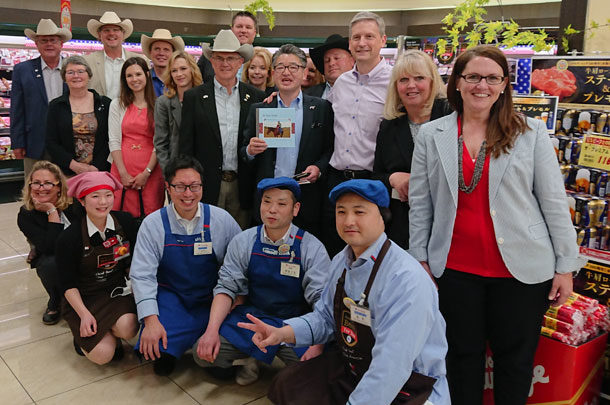The group, comprised of members of the Cattlemen’s Beef Board (CBB), the state beef councils of Idaho, Iowa, Colorado, Nebraska and Minnesota, along with other beef industry representatives, participated in several marketing events aimed at giving a name and a face to U.S. beef in Asia and teaching U.S. producers a bit more about the meat markets in Asia.
Jared Brackett, vice chair of the CBB, was part of the producer group. He says the group not only interacted with consumers and visited several grocery stores and restaurants, but also met with many influential food bloggers and chefs to learn how U.S. beef is prepared in Taiwan and Japan and to share how beef is cooked in the U.S. – like grilling a steak.
One event in Japan was devoted to showing how to grill steak “American-style.” “In Japan, they don’t have the opportunity to barbecue in their backyard like we do here, so they’re basically setting up barbecue clubs,” says Brackett. “You can rent a grill for two hours and barbecue with your family.” He says at the event, the roughly 60 consumers that attended were divided into groups and paired with a producer. “We barbecued with them and showed them how we barbecue in the U.S. and basically just enjoyed a meal with them. It was a great experience.”
Utilizing the whole cow
While touring Taiwan and Japan, the group learned about the different cuts of meat and beef products that are in demand in those markets compared to the U.S. “When we go to a Costco here in the U.S., in the meat case, it’s basically T-bones and rib-eyes, some roasts and ground beef,” Brackett explains. “When you go to the meat case in, say, Taiwan, it’s the same meat case, but it’s all very thinly sliced meat. They’re not selling lots of rib-eyes and T-bones; they’re selling thinly sliced meat that they use their hotpots or their ecogrills to cook, so it’s a different product. It reinforces the work that the USMEF has been doing to develop a taste for our meat over there, but also, we’re utilizing the whole cow.”
Brackett uses the example of cow tongue. Cow tongue runs for $6 a pound in Japan, where it is in high demand, while only bringing in a fraction of that on the U.S. market, where demand is much lower. “That puts a lot more dollars back in our producers’ pockets by basically marketing the whole animal,” he says. “On average, that adds $320 per head to fed cattle. Last year we did $8.3 billion worth of exports, so it’s a big deal what these companies like the USMEF are doing for us.”

Trade relations
Since the U.S. declined joining the revised Trans-Pacific Partnership (TPP), it has faced a significant disadvantage in the Japanese market compared to other major beef exporters who are part of the deal, but better times look to be on the horizon. “We’re on track to get some negotiations finished to put us back on the same level playing field as Australia, New Zealand and some other countries that are still part of TPP,” says Brackett. “It sounds like we’re on the right track to get back in 2020 to probably the exact same level, which is really good because the Japanese people really love our beef. It demands a premium, and they are willing to pay more for it.”
Brackett says the market in Taiwan is very different from Japan. There are no tariffs, and we also provide about 75% of the chilled beef imports to Taiwan, but the market for more costly high-quality beef is only starting to take off. “Between Japan and Korea, they just can’t afford to buy some of the product, and that’s why we have to be creative,” he says. “In Taiwan, instead of trying to do brisket, we’re trying to do tri-tip there because it’s not as popular and less pricey.”
Potential in China
According to Brackett, the challenge for U.S. beef in China isn’t so much the prohibitive tariffs, but more the nonscientific requirements like restrictions on beta-agonists and growth hormones. “It is just a barrier that the Chinese government has on us, and it can go away as soon as they want it to, but that’s policy stuff that we don’t control,” he says. “In my opinion, it’s a Coke versus Pepsi deal. We want to be in China, but just so they understand what quality U.S. beef is. We don’t want to be playing catch up 20 years from now trying to get them to switch from Australian or New Zealand beef.”
Takeaways
He says the American consumer is not competing with the Japanese or Taiwanese consumer for product because it’s a different type of product. Exporting more to Japan or Taiwan will not drive up the price of T-bones and rib-eyes here in the U.S. “We have to export so much of our product because we can’t consume it all at home, so it’s very important that we get as much money as we can out of that, and the way we do that is by marketing the whole animal, and that’s where your USMEF and other contractors that work with CBB and other organizations come into play,” he says. “By marketing the whole animal worldwide, we’re able to break that animal down and get the most bang for our buck in different places. In today’s day and age, that’s going to put more dollars back in our producers’ pockets than anything else will.” ![]()
PHOTO 1: U.S. producers visited several businesses, grocery stores and restaurants during their trip to Taiwan and Japan.
PHOTO 2: Marketing U.S. beef in Asia requires a different approach and different products than in the U.S. Photos courtesy of the Cattlemen’s Beef Board.

-
Carrie Veselka
- Editor
- Progressive Cattle
- Email Carrie Veselka








